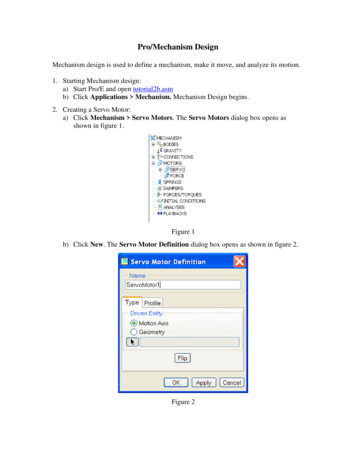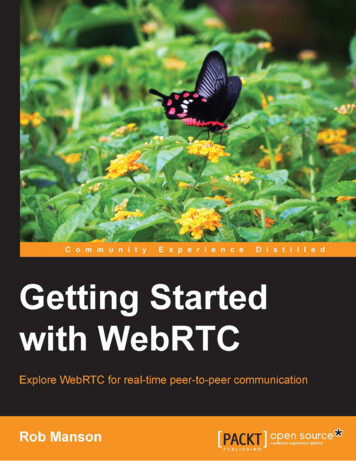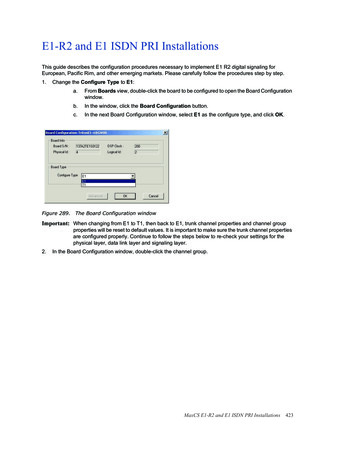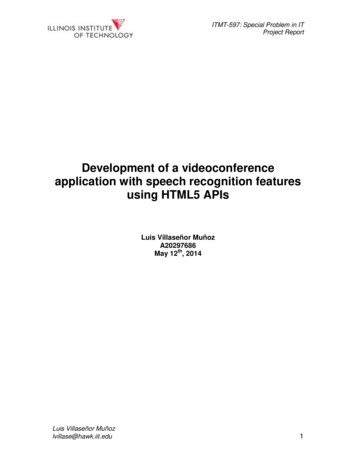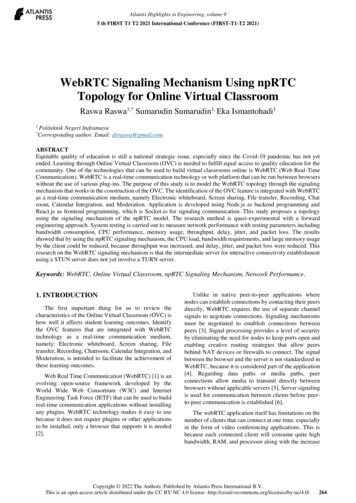
Transcription
Atlantis Highlights in Engineering, volume 95 th FIRST T1 T2 2021 International Conference (FIRST-T1-T2 2021)WebRTC Signaling Mechanism Using npRTCTopology for Online Virtual ClassroomRaswa Raswa1,* Sumarudin Sumarudin1, Eka Ismantohadi11Politeknik Negeri IndramayuCorresponding author. Email: drraswa@gmail.com*ABSTRACTEquitable quality of education is still a national strategic issue, especially since the Covid-19 pandemic has not yetended. Learning through Online Virtual Classroom (OVC) is needed to fulfill equal access to quality education for thecommunity. One of the technologies that can be used to build virtual classrooms online is WebRTC (Web Real-TimeCommunication). WebRTC is a real-time communication technology or web platform that can be run between browserswithout the use of various plug-ins. The purpose of this study is to model the WebRTC topology through the signalingmechanism that works in the construction of the OVC. The identification of the OVC feature is integrated with WebRTCas a real-time communication medium, namely Electronic whiteboard, Screen sharing, File transfer, Recording, Chatroom, Calendar Integration, and Moderation. Application is developed using Node.js as backend programming andReact.js as frontend programming, which is Socket.io for signaling communication. This study proposes a topologyusing the signaling mechanism of the npRTC model. The research method is quasi-experimental with a forwardengineering approach. System testing is carried out to measure network performance with testing parameters includingbandwidth consumption, CPU performance, memory usage, throughput, delay, jitter, and packet loss. The resultsshowed that by using the npRTC signaling mechanism, the CPU load, bandwidth requirements, and large memory usageby the client could be reduced, because throughput was increased, and delay, jitter, and packet loss were reduced. Thisresearch on the WebRTC signaling mechanism is that the intermediate server for interactive connectivity establishmentusing a STUN server does not yet involve a TURN server.Keywords: WebRTC, Online Virtual Classroom, npRTC Signaling Mechanism, Network Performance.1. INTRODUCTIONThe first important thing for us to review thecharacteristics of the Online Virtual Classroom (OVC) ishow well it affects student learning outcomes. Identifythe OVC features that are integrated with WebRTCtechnology as a real-time communication medium,namely: Electronic whiteboard, Screen sharing, Filetransfer, Recording, Chatroom, Calendar Integration, andModeration, is intended to facilitate the achievement ofthese learning outcomes.Web Real Time Communication (WebRTC) [1] is anevolving open-source framework developed by theWorld Wide Web Consortium (W3C) and InternetEngineering Task Force (IETF) that can be used to buildreal-time communication applications without installingany plugins. WebRTC technology makes it easy to usebecause it does not require plugins or other applicationsto be installed, only a browser that supports it is needed[2].Unlike in native peer-to-peer applications wherenodes can establish connections by contacting their peersdirectly, WebRTC requires the use of separate channelsignals to negotiate connections. Signaling mechanismsmust be negotiated to establish connections betweenpeers [3]. Signal processing provides a level of securityby eliminating the need for nodes to keep ports open andenabling creative routing strategies that allow peersbehind NAT devices or firewalls to connect. The signalbetween the browser and the server is not standardized inWebRTC, because it is considered part of the application[4]. Regarding data paths or media paths, peerconnections allow media to transmit directly betweenbrowsers without applicable servers [5]. Server signalingis used for communication between clients before peerto-peer communication is established [6].The webRTC application itself has limitations on thenumber of clients that can connect at one time, especiallyin the form of video conferencing applications. This isbecause each connected client will consume quite highbandwidth, RAM, and processor along with the increaseCopyright 2022 The Authors. Published by Atlantis Press International B.V.This is an open access article distributed under the CC BY-NC 4.0 license 4
Atlantis Highlights in Engineering, volume 9in the number of clients [7]. Signaling methods will affectthe network performance such as throughput, delay,jitter, and packet loss [8]. Due to resource limitations andthe use of different topologies for WebRTC videoconferencing, a WebRTC hybrid signaling mechanismwas created and implemented over a LAN and WANnetwork named WebNSM for video conferencing basedon Socket.io (API) and Firefox mechanisms. WebNSMis designed with a combination of different topologies,such as simplex, star, and mesh. WebNSM takes anaverage of 89 (milliseconds) to be ready and 111(milliseconds) to send requests and receive responses,even when the network is congested [9]. P2P-MCUapproach to support multi-party WebRTC conferencingwith common Android phones may cause some delay ( 500 ms), stable delay and perceptions were almostnegligible for the participants. P2P-MCU performance isquite stable and success rate build connection on 3Gnetwork almost 90%, which is much higher than innormal WebRTC. Experimental results of eight-partyvideo conferencing experiments show that our solutioncan reduce 64% CPU 35% bandwidth usage andconsumption for each participants compared to a pureWebRTC mesh network [10]. To compare theperformance of each SFU has been measured by bit rateand latency in video scalability testing conferencing usecases using a single SFU WebRTC media server. Theresults show that that such approach is viable, andprovide unexpected and refreshingly new insights on thescalability of those SFUs, that the decrease of bit rate issharper for Medooze [11].The studies carried out as described [9], [10], [11] stillhave shortcomings with regard to the effectiveness ofresources on WebRTC regarding audio and video mediastreams. This study aims to model the WebRTC topologythat works in the development of the Online VirtualClassroom (OVC) with the npRTC mechanism model.Therefore, this article aims to answer the researchquestion: How much influence does the npRTC signalingmechanism have on network performance andeffectiveness of resource devices in WebRTC on endusers?This paper is structured and described as follows, inpart 2 the material and research methods and theirimplementation and analysis are explained. In section 3,the results and discussion are described. Finally, section4 presents conclusions and future work.This research is used for the STUN serverintermediary server in the establishment of interactiveconnectivity, not involving the TURN server.2. THE MATERIALS AND METHODThe computer and network devices used in this studyare as shown in Table 1.Table 1. The testing material of the WebRTC signalingmechanismComponentDesktop PCWebcam;Audio deviceMonitorAudio deviceNetworkinfrastructuredeviceSistem OperasiProcessorRAMOperatingSystem TypeModeGigabyte Technology Co., Ltd.H81M-DS2Full HD webcamS24R35xMicrophone (High DefinitionAudio Device)802.11n NICWindows 10 HomeIntel Core i5-4570 CPU @3.20GHz 3.20 GHz8,00 GB64-bit Operating System, x64based processorThe research method used quasi-experimental with aforward engineering approach. The forward engineeringis the final step of the re-engineering process, while theforward engineering stage follows the stages of thegeneral model of re-engineering software, namelyconceptual, requirements, design, and implementation[12]. Forward engineering is the engineering whichmoves from high level to low level abstraction. In this thehigh level model or concepts are building to low leveldetails [13]. The forward engineering approach becomesthe research stage on the quasi-experimental method.The planning stage is the process of defining what is tobe achieved from the research conducted. The designphase is the process of creating and designing a newsystem. The development stage is the process ofachieving new knowledge and findings. The last stage isimplementation, namely the act of practicing the designthat has been formulated previously.2.1. ConsceptualWebRTC applications require signaling services forpeers to exchange network and media metadata. Oncesignaling occurs, video/audio/data is streamed directlybetween clients. Signaling is not defined by the WebRTCstandard, not implemented by its API to allow flexibilityin the technologies and protocols used. The signaling andthe servers that handle it are left to the WebRTCapplication developer to handle. Each peer in a WebRTCconnection tries to acquire a set of InteractiveConnectivity Establishment (ICE) protocol candidates.265
Atlantis Highlights in Engineering, volume 9The candidate represents the combination of IP address,port, and transport protocol to be used.Initiating a peer-to-peer connection requires somework such as a handshake mechanism to negotiateconnection parameters, and it implicitly assumes that thedestination server is reachable by the client—that is, theserver has a publicly routable IP address or the client andserver are on the internal network. the same one. Beforea connectivity check or session negotiation can takeplace, we must find out if the other peer is reachable andif the peer is willing to establish a connection. We haveto make offers, and partners have to return answers. Toexchange offers and answers between clients, we need ashared signal channel.In planning for WebRTC-based communication, itstarts using the Session Description Protocol (SDP) todescribe the parameters of the peer-to-peer connection.The first steps required to initiate a WebRTC connection:(1) initialize the shared signaling channel, (2) initializethe RTCPeerConnection object, (3) request video andaudio streams from the browser, (4) register local videoand audio streams with the RTCPeerConnection object,(5 ) generate SDP description (offer) of peer connection,(6) apply generated SDP as local description of peerconnection, (7) send generated SDP offer to remote peervia signal line2.2. RequirementsModerately152Bad251Sumber: TIPHONStandardization of network performance based on thedelay value is shown in table 4.Table 4. Standardization of network performance basedon the DelayDelay Category 1504Good150 s/d 3003Moderately300 s/d 4502Bad 4501Sumber: TIPHONStandardization of network performance based on theJitter value is shown in table 5.Table 5. Standardization of network performance based on theJitterJitter CategoryJitter (ms)IndeksVery good04Good0 s/d 753Moderately75 s/d 1252Bad125 s/d 2251Sumber: TIPHONTable 2. Standardize network performance based onThroughput2.3. DesaignThroughput(%)IndeksVery good1004Good753Moderately502Bad 251IndeksVery goodThe design of the signaling mechanism is carried outto obtain the required network service quality parameters.Standardization of network performance based on theThroughput value is shown in table 2.ThroughputCategoryDelay (ms)Several signaling mechanisms to establishconnections between users in WebRTC have beendeveloped by developers, including peer-to-peer, Star,Mesh, Selected Fowarding Unit (SFU), MultipointCentral Unit (MCU), Hybrid. The npRTC signalingmechanism is a combination of the Star and Mesh modelsshown in Figure 1.Sumber: TIPHONStandardization of network performance based onPacket Loss values is shown in table 3.Table 3. Standardization of network performancebased on Packet Loss valuesPacket LossCategoryPacket Loss(%)IndeksVery good04Good33Figure 1 npRTC signaling mechanismThe Figure 2 is peer-to-peer signalling mechanism.WebRTC basically allows web apps go create Peer-to-266
Atlantis Highlights in Engineering, volume 9Peer (p2p) communication. When web application needssome data or a resource, it fetches it from some serverand that’s it, video chat, by directly connecting tosomeone else’s browser. In order for two devices ondifferent networks to find each other, this process, calledsignaling, involves both devices connecting to a mutuallyagreed upon third server. Through this third server, thetwo devices can find each other, and exchangenegotiation messages.Figure 2 Peer to peer (p2p) signaling mechanismIn Mesh network all peers send their stream directlyto other connected peers in network individually, such asfigure 4.Figure 5. Peer to peer (p2p) in online virtual classroom3. RESULTS AND DISCUSSIONFigure 3 Mesh signaling mechanism2.4. ImplementationThe last stage is an implementating, which is an actof practicing a theory, method, and other things toachieve certain goals. The implementation of the test iscarried out in a basic computer network laboratory asshown in Figure 5.To communicate with other peers via a web browser,each client web browser must go through the followingsteps: (1) agree to initiate communication, (2) know howto find each other, (3) bypass firewall security andprotection, and (4) transmits all multimediacommunications in real-time. The four steps are carriedout through a signaling mechanism. In order to find outhow much influence the npRTC signaling mechanismmodel has on network performance and device resourceefficiency on end users, we have tested severalparameters. Then we compared it with the mesh signalingmechanism model.Testing of videoconferencing and whiteboardfeatures is carried out in groups with a certain number ofusers, namely 3 users, 6 users, and 15 users. However, wepreviously tested a peer-to-peer (p2p) signalingmechanism, consisting of 2 users.Figure 4 The basic computer network laboratoryThe implementation of WebRTC with p2p signalingmechanism is carried out via the https url shown in figure6. Tested the performance of computer resourcesused by the user, also tested the quality of networkperformance using wireshak.Figure 6. The Computer resource usage level foraudio communication in mesh signalingmechanism267
Atlantis Highlights in Engineering, volume 9characteristics resulting from the mesh signalingmechanism.Figure 7. The Computer resource usage level forvideo communication in mesh signalingmechanismFigure 10. The Computer resource usage level foraudio communication in npRTCsignaling mechanismFigure 8. The network service of the quality foraudio communication in mesh signalingmechanismFigures 6 and 7 show that bandwidth consumptionusing a mesh signaling mechanism has an increasingsimilarity between audio streams and video streams, inline with the increasing number of clients, in this test 3users, 6 users, and 15 users. To stream video requiresmore bandwidth than audio stream. The same goes forCPU performance and memory usage. The following inFigures 8 and 9 show the network service qualityFigure 9. The network service of the quality forvideo communication in mesh signalingmechanismFigure 11. The Computer resource usage level forvideo communication in npRTCsignaling mechanismThe Jitter characteristic is the average delay, but thegraphs shown in Figures 8 and 9 do not describe theaverage delay. The author's assumption is that TURNServer has not been used in establishing connections inthe WebRTC system. The throughput characteristics areshown to decrease in line with the increasing number ofclients. The characteristics of delay, jitter, and packet lossincrease in line with the number of clients.Furthermore, testing has been carried out on the useof the npRTC model signaling mechanism with the samenumber of users, namely 3 users, 6 users, and 15 users.The level of use of computer resources for audio andvideo communication is shown in Figures 10 and 11. Theresults of the network service quality test are shown inFigures 12 and 13.268
Atlantis Highlights in Engineering, volume 9performance of computer resource usage, includingbandwidth consumption, RAM performance, andperformance. memory usage, as well as in terms ofnetwork service quality. If it is described in a line chart,the comparison can be shown in Figure 14.Figure 12. The network service of the qualityfor audio communication in npRTCsignaling mechanismTesting of the npRTC model signaling mechanismand then comparing it with the mesh model signalingmechanism has been shown to improve the performanceof the resources used by the user, as well as to improvethe quality of network services. Thus our findings arenovelty of the development of signaling mechanisms toestablish real-time communication. However, furtherresearch needs to involve TURN Server as anintermediate server for establishing interactiveconnectivity.4. CONCLUSIONThis paper describes the methodology and datasources used for network performance testing with testparameters including: bandwidth consumption, CPUperformance, memory usage, throughput, delay, jitter andpacket loss.Figure 13. The network service of the qualityfor video communication in npRTCsignaling mechanismBased on the test results as shown in the line chartabove, the use of the npRTC signaling mechanism whencompared to the mesh model shows an increase inThe results presented in this report clearly that in thispaper, the npRTC signaling mechanism in WebRTC isused for video conferencing and whiteboarding in anonline virtual classroom and tested in a realimplementation among 15 PCs. Other than that, npRTCsignaling can be considered as a new signalingmechanism because it provides flexible communicationamong users. In addition, it can be applied in differentapplications, such as gathering a group of people on onecall at a time, conferences between users, betweenteachers and students. The npRTC signaling requires anaverage of 76 (milliseconds) for ready and 103(milliseconds) for sending requests and receivingresponses, even when the network becomes dense. An indepth explanation of CPU performance, memory usage,signaling performance, mesh topology, and p2p topologyin physical implementation has been done.The weak aspect of this research on the WebRTCsignaling mechanism is that the intermediate server forinteractive connectivity establishment using a STUNserver does not yet involve a TURN server, so the mediaflow is still unstable.REFERENCES[1] [1] E.M. Clarke, E.A. Emerson, Design andsynthesis of J.-I. B. Cullen Jennings, HenrikBostr om, “Webrtc 1.0: Real-time communicationbetween browsers,” 01 2021, [Online].Figure 14. The signaling mechanism from Meshto npRTC model.WebRTC communication performance, in terms of the[2] F. Alamsyah, D. P. Kartikasari, and F. A. Bakhtiar,“Implementasi WebRTC Pada Sistem BroadcastPembelajaran Untuk Menampilkan BahasaIsyarat,” Jurnal Pengembangan Teknologi269
Atlantis Highlights in Engineering, volume 9Informasi dan Ilmu Komputer., Vol. 3, No. 10, pp.10331-10336, Oktober 2019.General aspects of Quality of Service (QoS),DTR/TIPHON- 05006 (cb0010cs.pdf). 1999.[3] Aditya, B.R., and Permadi, A.,” Implementation ofutaut model to understand the use of virtualclassroom principle in higher education,”International Conference on Computing andApplied Informatics, Journal of Physics: Conf.Series 978 (2018) 012006, 2017.[9] Edan, N., Al-Sherbaz, A., & Turner, S. (2018).Design and implement a hybrid WebRTCsignalling mechanism for unidirectional & bidirectional video conferencing. InternationalJournal of Electrical and Computer 1/ijece.v8i1.pp390-399[4] Edan, N., & Abdullah, E. Y. (2020). Design andimplementation of a novel secured and wideWebRTC signalling mechanism for multimediaover internet. International Journal of Electricaland Computer Engineering, 10(5), P54305435[5] Kaushal, J., Khadtare, K., Hariharan, S., Gandevar,K., “Video Conferencing Using Webrtc,”International Journal of Engineering AppliedSciences and Technology, Vol. 5, Issue 4, pp. 539545, , ISSN No. 2455-2143.[6] Pathare, K.G., Chouragade, P.M., “WebRTCImplementation and Architecture Analysis,”International Journal of Scientific & EngineeringResearch, Volume 7, Issue 2, February-2016, ISSN2229-5518.[7] Habibur Rahaman, M. H., “A Survey on Real-TimeCommunication for Web,” Scientific ResearchJournal (SCIRJ), Volume III, Issue VII, July 201539, ISSN 2201-2796.[8] TIPHON, 1999. Telecommunications and InternetProtocol Harmonization Over Networks (TIPHON)[10] Fai Ng, K., Yan Ching, M., Liu, Y., Cai, T., Li, L.,& Chou, W. (2014). A P2P-MCU Approach toMulti-Party Video Conference with WebRTC.International Journal of Future Computer .7763/ijfcc.2014.v3.319[11] Andre, E., Le Breton, N., Lemesle, A., Roux, L., &Gouaillard, A. (2018). Comparative study ofWebRTC open source SFUs for videoconferencing. 2018 Principles, Systems andApplications of IP Telecommunications, IPTComm2018. https://doi.org/ 10.1109/IPTCOMM.2018.8567642[12] Mauluddin, S., & Sidik, R. (2020). ForwardEngineering in Student Mark RecapitulationApplication. IOP Conference Series: org/10.1088/1757-899X/879/1/012055[13] Singh, N. (2012). A Review of ReverseEngineering Theories and Tools. InternationalJournal of Advanced Engineering Research, 2(1),1–5.270
Communication). WebRTC is a real-time communication technology or web platform that can be run between browsers without the use of various plug-ins. The purpose of this study is to model the WebRTC topology through the signaling mechanism that works in the construction of the OVC. The identification of the OVC feature is integrated with WebRTC
